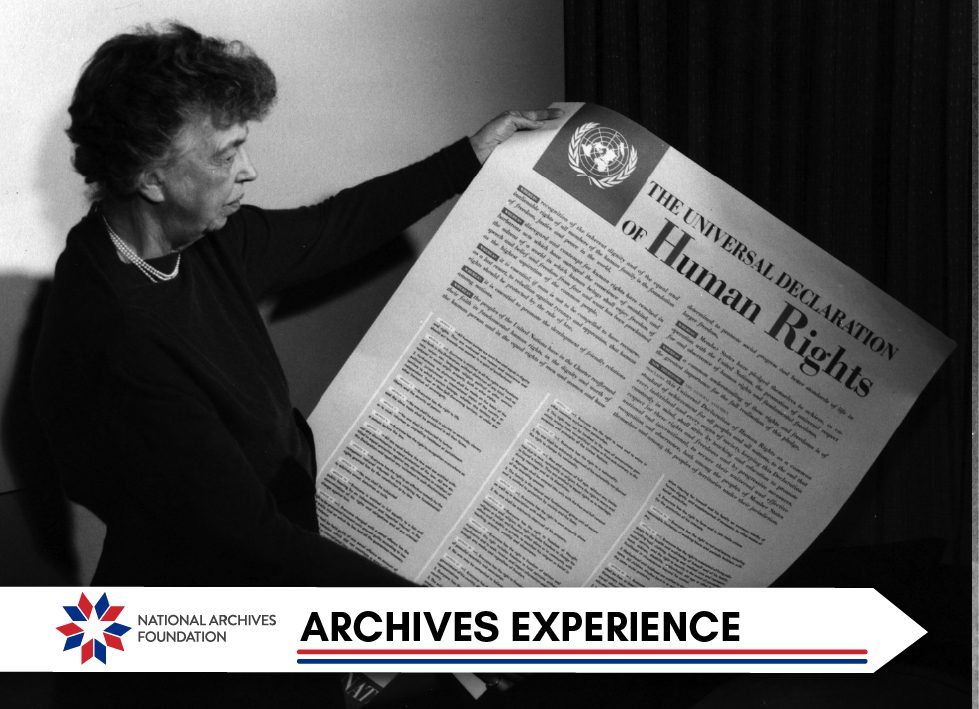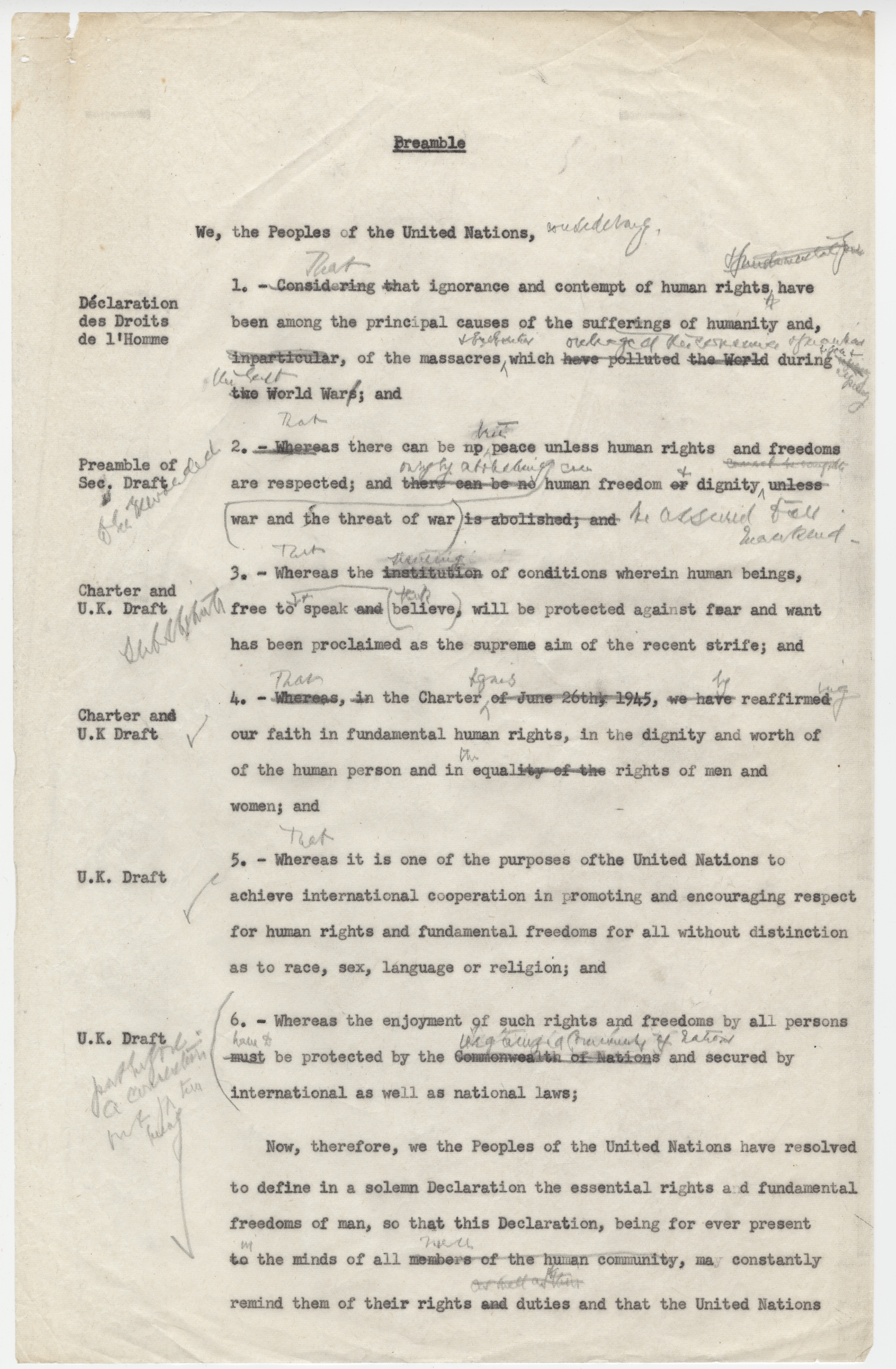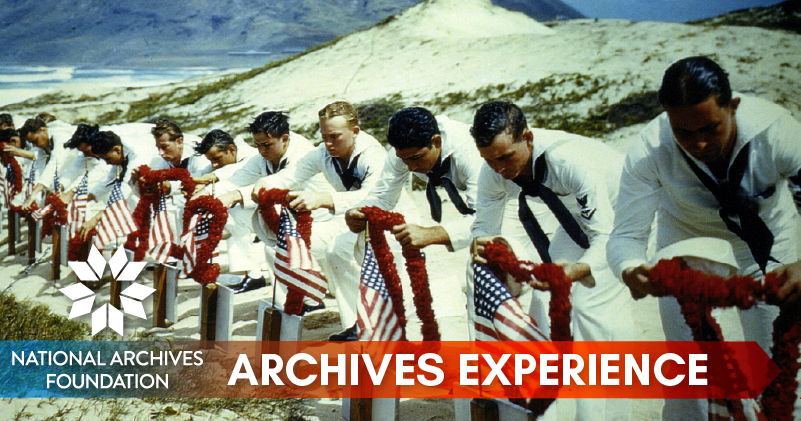A Universal Declaration

On July 4, 2026, our nation will celebrate the 250th anniversary of the Declaration of Independence, a landmark document that stood up for the rights of the individual in the face of absolute monarchy. But in this newsletter, we’re celebrating a different declaration, albeit a much younger one.
This month marks the 75th anniversary of the Universal Declaration of Human Rights. Crafted in part by one of the country’s most active first ladies, the declaration was an early step of the newly born United Nations in international cooperation…
History Snack

Childhood photo of Eleanor Roosevelt
National Archives Identifier: 598929
Adopted by the United Nations General Assembly on December 10, 1948, the Universal Declaration of Human Rights sets out, in stirring rhetoric and with great clarity, fundamental human rights that should be protected worldwide.
The atrocities committed by the Nazis during World War II and the plight of the millions of war refugees were the foremost issues facing the fledgling United Nations when it was founded in April 1945. The establishment of a Commission on Human Rights was one of the new organization’s first actions.
The declaration was the result of more than two years of intense work by an international commission led by Eleanor Roosevelt, the widow of U.S. President Franklin Delano Roosevelt and a political activist in her own right.
Eleanor Roosevelt was born in New York City into a wealthy American family in 1884. She was educated in England at the Allenswood School, an excellent institution headed by Marie Souvestre, a French feminist. After she graduated and came home to the United States, Eleanor worked in a settlement house on the Lower East Side of Manhattan, which gave her a true taste of the experiences of the underprivileged.

FDR, Eleanor, and their children Anna and James
National Archives Identifier: 196066696
Eleanor married Franklin Delano Roosevelt on March 17, 1905, and she devoted the next decade to raising her six children and nurturing Franklin’s burgeoning political career. When World War I broke out, however, she joined the American Red Cross and volunteered in Navy hospitals. She also participated in the Women’s Division of the New York State Democratic Committee, the League of Women Voters, and the Women’s Trade Union.
When FDR was elected President, Eleanor continued to advocate for minorities and the poor. Because the President’s health prevented him from traveling very much, she traversed the country to keep him advised about the situation in the country. In 1935, she began writing a syndicated newspaper column, “My Day,” which she continued to publish until her death in 1962.

Memo from Eleanor to FDR on African Americans in the military
National Archives Identifier: 311315458 page 2
When FDR died in 1945, Eleanor was both bereft and out of a job. In December of that year, Harry Truman asked her to join the first U.S. delegation to the United Nations, and although she was concerned about her lack of diplomatic experience, she agreed. She turned out to be a natural stateswoman, advocating for the millions of refugees who had been displaced by the war.

First nomination of a delegate to the UN by Harry Truman
Source: NARA’s Prologue Magazine
In 1946, the UN’s Economic and Social Council (ECOSOC) created a Commission on Human Rights in 1946 and appointed Eleanor Roosevelt to it. Based on her work on behalf of the needy, impoverished, women, minorities, and other underserved populations and her diplomatic success at the UN, the other 17 members of the commission unanimously elected her chair.
On January 27, 1947, at Lake Success, New York, the commission, whose members, including Roosevelt, represented Australia, Belgium, Byelorussia, Chile, China, Egypt, France, India, Iran, Lebanon, Panama, Philippines, Ukraine, the USSR, the United Kingdom, the United States, Uruguay, and Yugoslavia, began its work by discussing what should be included in an international bill of rights. Differences of opinion emerged very quickly, mostly because representatives of different nations had different attitudes about individual rights versus the rights of the state.

FDR and the 4 Freedoms Speech
Source: FDR Library
After considerable and lively debate, the commission agreed that Charles Malik of Lebanon, P. C. Chang of China, Roosevelt, and the group’s secretary, John Humphrey of Canada, would draw upon the group’s discussions to prepare a draft that they would present to the rest of the commission in December. When the French and Soviet members protested that there were no Europeans in the group, Roosevelt added five more members: Hernán Santa Cruz from Chile, René Cassin from France, Geoffrey Wilson from the United Kingdom, Vladimir Koretsky from the Soviet Union, and Colonel William Roy Hodgson from Australia.
Humphrey then drafted a document based on the commission’s discussions and turned it over to the subcommittee, which then worked on it for the next 18 months. When they were done, the document included a preamble as well as a list of rights. The full commission reassembled in Geneva in December, where they agreed that they would produce a declaration rather than a covenant because the former, unlike the latter, is not legally binding. At this point, the conversations became devoted to discussions of the meaning of each individual word, which Roosevelt found very tiresome. She wanted the declaration to be accessible to ordinary people, not a document written exclusively in thorny legalese.

Eleanor Roosevelt handwritten revisions pg. 1
Source: FDR Library

Eleanor Roosevelt handwritten revisions pg. 2
Source: FDR Library
It took three months of deliberations, but on December 7, the third committee of the commission voted 29 to 0 with 7 abstentions to adopt the Universal Declaration of Human Rights. They sent the declaration to the General Assembly, which adopted it by a vote of 48 to 0 on December 10. The assembly then gave Eleanor Roosevelt a standing ovation. She later said the declaration “may well become the international Magna Carta of all men everywhere.” She considered it her greatest accomplishment.

Eleanor Roosevelt and the Universal Declaration of Human Rights
National Archives Identifier: 6120927
The Universal Declaration of Human Rights consists of a preamble and 30 articles that delineate the rights to which every human being on Earth is entitled. They include, among others, the right to freedom and equality, safety from slavery and torture, freedom of movement within one’s own country, the freedom to move to a different country, equal protection under the law, the right to asylum, freedom to marry, have a family, and participate in religious practices, and the right to own property.
The declaration was criticized at its inception by some socialist countries for favoring individual rights over collective rights, while some in the United States said it went too far toward supporting socialist views. Some nations have objected to the clauses about religious freedom, family, and marriage. Overall, however, the declaration has stood the test of time as the basis of human rights law since its adoption.

Eleanor Human Rights exhibit at NARA
Source: NARA’s Prologue Magazine

Ford proclamation of Human Rights and Bill of Rights Day pg. 1
Source: NARA’s Prologue Magazine

Ford proclamation of Human Rights and Bill of Rights Day pg. 2
Source: NARA’s Prologue Magazine

Read the entire UN Declaration of Human Rights here
Source: The United Nations

View this profile on InstagramNational Archives Foundation (@archivesfdn) • Instagram photos and videos




